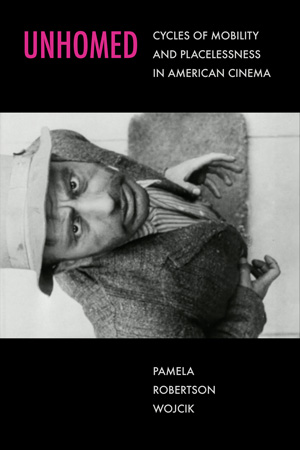
Unhomed examines America’s ambivalent and shifting attitude toward placelessness through marginalized figures of mobility in film. The book examines films that show characters as unhomed and placeless, mobile rather than fixed: failing, resisting, or opting out of the mandate for a home of one’s own. These narratives show a tension in the American imaginary between viewing homelessness as, on the one hand, deviance, or a threat, and, on the other, as freedom and independence. At the same time, Unhomed provides a new way of viewing American film history. While these stories may appear to be insignificant trend-driven narratives of people on the fringe, they are in conversation with more conventional narratives of success, social mobility, and home: they are the flip side. Rather than marginal, these films about unhomed figures remind us that genres of precarity have been central to the American cinema (and story) all along.
Unhomed considers mobility and placelessness in five different historical moments and distinct film cycles. Often, film cycles emanate from moral panics about a perceived threat to societal values or interests. These panics are media-driven projections of an alleged social threat onto figures whose behavior—and, here, specifically, their status as unhomed, mobile, and placeless—is perceived as deviant and dangerous. Film cycles both exploit and fuel moral panics, ginning up concern about the threat, but they often marshal potentially contradictory discourses and create sympathy for the supposedly deviant or troublesome figures rather than support the moral panic’s attack on them. By looking at distinct film cycles, Unhomed seeks to explore why and how ideas about mobility and placelessness come to the fore at certain points in time, what anxieties and/or fantasies they manifest, and how they change over time.
The film cycles are about 1) the figure of the tramp as a ubiquitous and threatening presence in the cultural imaginary from the start of cinema until World War II; 2) the “veteran problem” in the years after World War II when the temporary unhoming of soldiers and civilians alike are seen to be life-changing (as citizens are liberated from conventions associated with civilized life and unmoored from the norms of society related to sex, marriage, race relations, and more); 3) the figure of the female hitchhiker in early 1970s films whose voluntary countercultural precarity and mobility threaten ideals of home and family and challenge conceptions of youth; 4) the unhoused that appeared as the new category of “homeless” was just emerging in the 1980s and produced a moral panic that denigrated the unhoused as a scourge on the gentrifying city; and 5) the contemporary precariat in 21st century realist films that reveal the normative orientation itself—the assumptions about social mobility and the ability to successfully enter adulthood (i.e., having a home, family)—as having been bent, distorted or derailed.
Of course, homelessness is one of the major problems facing society today. Part of the impetus for this project was to think historically about representations of homelessness to see how media, and especially films, negotiate attitudes toward the homeless. But rather than simply focus on stereotypical ways we typically imagine the homeless—in terms of people in poverty living on the street—and look for examples of that in cinema, I worked from the films themselves to see what they could uncover about attitudes toward mobility and placelessness. In the process, I discovered different modes of being unhomed that were more varied and surprising than a consideration of “homeless films” might indicate. This much more complex and contradictory picture of the past illuminates aspects of history that have been forgotten or lost.
Unhomed considers different ways of being unhomed—both by those who choose to be uprooted and mobile and those who have no choice; those who resist the trappings of home and those who desire them; those who perceive themselves as free and those who perceive themselves as unmoored or homeless. Unhomed also considers different kinds of mobility, including walking, train travel, public transit, and hitchhiking; and different scales of mobility, ranging from travel across the country and overseas to small circuits of movement within a city or neighborhood. These include the tramp’s movement on foot and by rail, governmental movement of troops by train during World War II, young women hitchhiking, the wanderings of homeless people in urban centers, and the constant movement of workers in a gig economy. In Unhomed, I consider placelessness as being without anchor and moving through transient non-places; as not confined to place, not bounded or defined; and as having no place in the social fabric, being marginal or even disposable.
In looking at five distinct film cycles, I endeavor to recover the density of representation, to chart patterns across a large body of films, and to uncover themes, aesthetics, and plots that traverse large numbers of films. The broad investment in the unhomed documented with a vast number of film examples across historical cycles, shows a different side of American cinema and underscores its affective and ideological investment in precarity. Unhomed is about a curiously neglected dominant in American culture: mobility without manifest destiny, movement without terminus, geographic mobility that does not produce hope of social mobility. Unhomed is also about the panics, anxieties, desires, and envy projected into figures who are unhomed, mobile, and placeless. In thinking through film about the various ways in which we imagine the unhomed, I am hoping that this project makes us see the unhomed, and see them differently.
The most surprising chapter in the book is probably Chapter 3, “Adrift: The Freedom of the Female Hitchhiker.” It deals with the brief but intense cycle of exploitation films about young hitchhiking runaways roughly bracketed by The Young Runaways (Driefuss 1968) and the TV movie Diary of a Teenage Hitchhiker (Post 1979) that consists of a mixture of mainstream studio films, exploitation pictures, drive-in movies, skin-flicks, and TV movies of the week that, together, fit Jeffrey Sconce’s category of “paracinema,” a category of film that includes entries from various subgenres of film including rock ‘n’ roll movies; movies about beatniks, hippies and dope; monster movies, surf films; hillbilly films, softcore porn and more. This seventies cycle focuses on the young female hitchhiker as an emblem of quasi-feminist independence and countercultural nonconformity, largely understood as sexual liberation, and the concomitant risks of – and punishments for – her freedom and mobility. They yoke female hitchhiking to not only transgressive sexuality and criminality but also freedom, stitching together anxieties related to the counterculture, voluntary precarity, runaway youth, and women’s liberation.
Most discussions of late 1960s and early 1970s hitchhiking films focus on films like Easy Rider (Hopper 1969), Vanishing Point (Sarafian 1971), and Two-Lane Blacktop (Hellman 1971). True, all of these include at least some attention to hitchhiking, but the focus of the films and the discourse around them tend to emphasize masculinist fantasies of freedom and existential crisis. In ignoring the female hitchhiking films, we not only fail to understand broader conceptions of the road and countercultural travel in the late 1960s and early 1970s, but obscure—once again—both the reality and representations of female mobility. Similarly, when critics discuss youth cinema of the period, these films about young runaways and female hitchhikers are never mentioned, even in instances when critics seek to expand the conception of what “counts” as youth cinema. Largely viewed as a period lacking almost any youth film—save the nostalgic American Graffiti (Lucas 1973) set in the early 1960s—let alone films focused on girls, this critical lacuna about the early 1970s negates the place (or rather placelessness) of young countercultural women who were quite prominently represented, but who do not fit most conceptions of youth or youth film.
The lack of attention to hitchhiking in film is not just a failure of the canon, but reflects a broader dismissal of hitchhiking as a largely forgotten fad. However, in both its practice and its filmic representation, hitchhiking represents a once-important cultural dominant that offers an alternate model of mobility and placelessness. Rather than only a means of getting from point A to point B, hitchhiking was, for a time, a crucial mode of travel and lifestyle for a generationally defined counterculture whose participants were mobile and deliberately unhomed.
I hope that this book leads readers to see American film history differently, to recognize how much of American cinema grapples with mobility and placelessness, and also to consider the various discourses about homelessness, mobility, and placelessness that show deep cultural anxieties. I also hope this book leads people to watch less- or un-familiar films, such as the tramp films, Lois Weber’s Suspense (1913) or Girls of the Road (Grinde 1940); films about the veteran problem like In the Meantime, Darling (Preminger 1949) and Till the End of Time (Dymytryk 1946); films about hitchhiking like Ida Lupino’s noir The Hitch-Hiker (1953) or the surprisingly avant-garde TV movie Maybe I’ll Come Home in the Spring (Sargent 1971); films about the homeless like Times Square (Moyle 1980) or Sidewalk Stories (Lane 1989), or recent neo-realist films like Rahmin Bahrani’s films Chop Shop (2007) and Man Push Cart (2005). Ideally, they will return and re-examine such well-known films as tramp films featuring Chaplin’s Little Tramp or Sullivan’s Travels (Sturges 1941); post World War II films like The Best Years of Our Lives (Wyler 1946); hitching films like Detour (Ulmer 1945); or homeless films like Terry Gilliam’s The Fisher King (1991). Ideally, I’d like people to reflect on contemporary discourses and anxieties about the unhomed and unhoused, and resist efforts to demonize them.


Pamela Robertson Wojcik is the Andrew v. Tackes Professor of Film, Television, and Theatre at the University of Notre Dame, a Guggenheim fellow, and former President of the Society for Cinema and Media Studies. She is author of Gidget: Origins of a Teen Girl Transmedia Franchise (2020), Fantasies of Neglect: Imagining the Urban Child in American Film and Fiction (2016), The Apartment Plot: Urban Living in American Film and Popular Culture, 1945 to 1975 (2010), and Guilty Pleasures: Feminist Camp from Mae West to Madonna (1996).